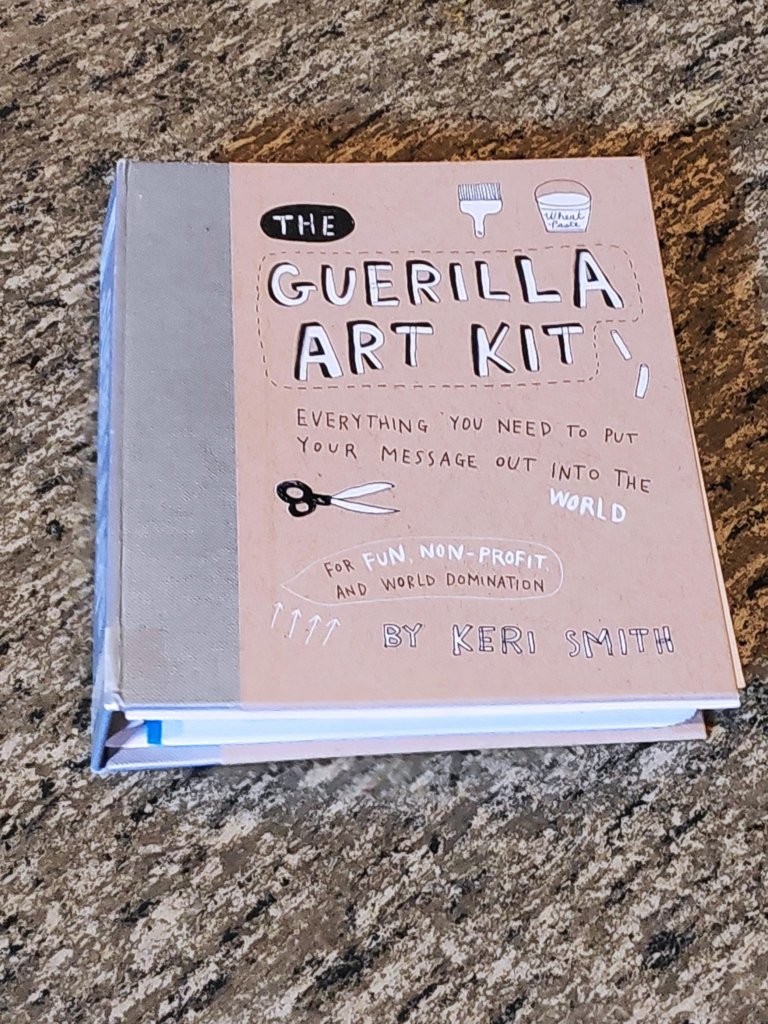
2023 is the year for guerilla art. It is not really a matter of choice. The world is burning, and the insanity of fossil fuel consumption has to stop. This weblog post is the second of two parts. It is about the hows, developing skills to become a guerilla artist. The first part was about the whats, supporting Tuvalu’s call for a fossil fuel non-proliferation treaty.
Guerilla arts #1
Yet another of my favourite books is The Guerilla Art Kit (2007). Keri Smith, the author, taught conceptual illustration at Emily Carr University of Art and Design, in Vancouver. She then went on to live in NYC. She is a street art enthusiast, and regards guerilla art as free, accessible and for everyone. She then encourages everyone to find their inner guerilla artist, quoting Mahatma Gandhi (1869 – 1948): “Be the change you want to see in the world.”
The Guerilla Art Kit is about leaving your mark. Yet, all of the exercises in Keri’s book/ kit are meant to be temporary/ transitory. She challenges readers to make pieces that embody impermanence. The biggest hurdle in creating guerilla art is deciding what ideas a person wants to promote.
Guerilla arts #2
Approaches to guerilla art:
1. beautifying: altering surroundings.
2. questioning: challenging the status quo.
3. interacting with people or the environment.
4. Reflect on the three things you want to put into other people’s heads.
Essentials: small toolkit, paint, wheat paste, brushes, gloves, something to carry leave-behinds and/ or stensils, clothing with pockets, that doesn’t signal deviance. Consider high-vis clothing, they can make you anonymous day or night.
Guerilla arts #3
Why is advertising in public spaces (billboards, bus shelters, etc) considered acceptable, but free personal expression is regarded as damaging, if not illegal? It may be preferable to post things on temporary construction walls, than on privately owned buildings.
Scouting is a preliminary step to producing guerilla art. Look for potential locations (Keri suggests: temporary walls, empty planters, objects that could be turned into characters) but based on the project a person wants to do. Avoid: security cameras, signs prohibiting posters/ signs, police.
Start small. Choose a familiar place. Suggestions: quiet alleys or in the woods. Decide the time of day that feels right. Work quickly. Bring a lookout.
Guerilla arts #4
My 2023 Guerilla art project will support Tuvalu and demand an international fossil fuel non-proliferation treaty, which would phase out the use of coal, oil and gas.
I am especially critical to the greenwashing of hydrogen. The various colours of hydrogen were discussed in a weblog post, nominally about Toyota.
To begin with, everyone loves hydrogen because, when it burns, it combines with oxygen to create energy = heat, with water as the resulting end product: 2H2 + O2 → 2H20. That means there is no production of carbon dioxide. Unfortunately, some methods used to create hydrogen produce carbon dioxide.
Blue hydrogen is hydrogen produced from natural gas using steam methane reforming, where natural gas is mixed with very hot steam = water = H20, and a catalyst. A chemical reaction occurs creating hydrogen and carbon monoxide: CH4 + H20 → 3H2 + CO. More water is then added to that mixture, turning the carbon monoxide into carbon dioxide and more hydrogen: CO + H20 → H2 + C02 , or as a combined equation: CH4 + 2H20 → 4H2 + C02. If the carbon dioxide emissions are captured and stored underground, the process is considered carbon-neutral. The resulting hydrogen is labelled blue.
This is controversial engineering. One challenge is methane emissions from fugitive leaks = leaks of methane from the drilling, extraction, transportation and processing. Some estimates place these at between 10 to 20% of the gas extracted.
Methane does not last in the atmosphere as long as carbon dioxide, but does more damage as a greenhouse gas. Over 100 years, one gram of CH4 is equivalent to 28 – 36 g of CO2. Even if the amount of methane that escapes into the atmosphere is 10% of that extracted, it represents, somewhere around three times the damage as the CO2 produced from burning methane.
In Norway, Shell, Aker Clean Hydrogen and CapeOmega are going to produce hydrogen at a Hydrogen Hub using natural gas (mostly methane) from a local processing plant on the island of Aukra, near Molde. The gas would come ashore from the Ormen Lange field in the North Sea, to be initially processed at the Shell plant at Nyhamna.
Shell is also an owner of the Northern Lights Joint Venture, a CO2 transportation and storage partnership, which it claims will provide emission-free hydrogen to consumers, because all the emissions will be captured and stored. I have serious doubts about their capability to achieve this.
The guerilla art project about this situation, will start life just behind the workshop facing Trondheim fjord. In particular, it will look at evocative but non-descriptive names, such as Northern Lights, that lull people into accepting damage because of a cute name.

